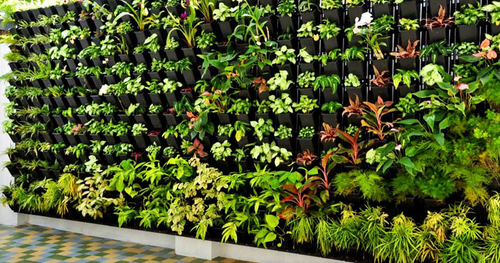Working towards greener and cleaner tomorrows.
One can walk under a cacophony of trees in certain areas of Mumbai, but I believe that this will only be for a few more years. I lived in a quiet area consisting mainly of 3 to 4 storeyed buildings before the beginning of uncontrolled development in the city. There was a time when I would stare up from a distance and see the clear blue sky, or yellow gulmohars in the distance. Now, all that is left are cranes and skyscrapers. Apart from the fact that the disorganized popping up of buildings is ruining whatever aesthetic value the city has left, the other major consequence of this development is the reduction in green spaces in Mumbai and other urban cities. However, with the current increase in the rate of population, especially in a city like Bombay, the urban sprawl cannot be escaped.
Now that urbanization has and continues to take up most of the space around us, green walls i.e. living walls seem to be a solution for the coexistence of green spaces in the city and the need for development with the growing population. Green walls, revolutionized by a French Botanist called Patrick Blanc, are plants grown on walls and other structures through scientific methods. Currently, they are the best bet in boosting limited spaces. Green walls make reforestation and green living possible within the confines of an urban city.
It is a well-researched fact that trees and plants are good for a person’s psychological and physiological health; from lowering stress levels to improving the immune systems. Studies have proven the effect of indoor plants on stress hormones. Phytoncide is a compound derived from plants, which seems to improve immune system functions. In fact, in 1982, Japan made Forest Bathing a part of their national public health program.

The most important benefit of having green walls is curbing air pollution. Plants improve indoor air quality and clear the air of harmful toxins and dust. Since the past few years, an increasing number of countries are experiencing hotter summers with every passing year; it will continue to get worse. Heat waves are increasing health problems, causing a general change in the working abilities and mental state of people, making them angrier and exhausted during summers, and even causing deaths. An abundance of trees and plants can lower temperatures making the city cooler. A primary school in Singapore created a vertical green wall in the school to educate its students about global warming. This green wall reduced the temperature in the school by 2 to 3 degrees.
How one can grow a vertical garden at home is explained well by Selina Sen in her article here. Most of us know about the added benefits of having plants at home, but we rarely consider the benefits of having them in our city. Individually taking up the initiative of growing living walls at home is wonderful but to reap the benefits of this concept, we need more than just in-house gardening. The true effects of this novel initiative will only be seen when there is implementation at a local and nationwide level.
Other countries have already begun making these ‘green walls’ a part of their major cities. Sydney is working on a Green Roofs and Walls Policy Implementation Plan. In Singapore, the Urban Redevelopment Authority provides incentives to builders for creating green spaces. Airports are installing green walls to ensure better journeys. Architects around the world have embraced green walls and built urban structures and buildings which have vertical gardens. It is critical that in a tropical country like India which has really begun to feel the effects of global warming, such an initiative needs to be strongly encouraged.
That being said, it is heartening to know that in India, multiple cities have taken the initiative to build living walls, Bengaluru being the first. Ahmedabad, Bengaluru and Mumbai have incorporated the concept by building vertical gardens and living walls on pillars under flyovers. Environmentalists, botanists, architects and lawmakers can and must come together and learn from other models in the world and thus work together to reclaim our disregarded spaces.
Feature Image Credit: Stefano Boeri Architetti
Shivangi Adani is a Volunteer Researcher at One Future Collective.